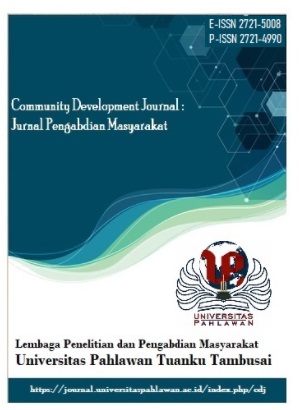An Analysis of EFL Learners' Learning Style in Online Speaking Class
DOI:
https://doi.org/10.31004/jrpp.v3i2.1325Keywords:
Pelajar EFL, Gaya Belajar, Keterampilan Berbicara, Pembelajaran OnlineAbstract
Penelitian ini bertujuan untuk melaporkan data tentang jenis gaya belajar siswa yang digunakan siswa di kelas berbicara online. Data dianalisis menggunakan The VARK Questionnaire oleh Neil Fleming. Penelitian ini menggunakan metode kualitatif deskriptif. Metode ini bertujuan untuk membuat deskripsi, ilustrasi secara sistematis, faktual dan akurat tentang fakta-fakta objek penelitian. Penelitian ini dapat memberikan pemahaman tentang empat jenis gaya belajar yang digunakan di kelas berbicara online. Subjek penelitian ini adalah siswa yang berusia 19-23 tahun. Untuk menganalisis data, data ditampilkan dalam penelitian sesuai dengan jenis gaya belajar. Hasil penelitian menunjukkan bahwa gaya belajar yang paling sesuai pada siswa kelas berbicara online adalah auditory.References
Adedoyin, O.B & Emrah Soykan (2020): Covid-19 pandemic and online learning: the challenges and opportunities, Interactive Learning Environments, DOI: 10.1080/10494820.2020.1813180.
Ali,S. (2011) Investigating Students’ Main Learning Style Preferences. Arab WorldEnglish Journal 2 (2): pp. 71-90
Alonso, F., López, G., Manrique, D., & Viñes, J. M. (2005). An instructional model for web-based e-learning education with a blended learning process approach. British Journal of Educational Technology, 36(2), 217-235.
Arjulayana. 2016. Indonesian Students’ learning Style in English Speaking Skill. Dinamika Hunt, Vol. 1, no. 2, 1-9.
Arkorful, V., & Abaidoo, N. (2014). The role of e-Learning, the advantages and disadvantages of its adoption in higher education. International Journal of Education and Research, 2(12), 397 – 410.
Bygate, M. (1987). Speaking. Oxford: Oxford University Press.
Chi-Hung Cheng. (2001). Preferred Learning and Teaching Styles at a Selected Junior College in Taiwan. Newyork: Bell Howell & Information and Loaning Company.
Cooze, M. & Barbour, M. (2005). Learning styles: A focus upon e-learning practices and pedagogy and their implications for designing e-learning for secondary school students in Newfoundland and Sabtador. Malaysian Online Journal of Instructional Technology, 2(1), 1-9.
Dunn, R.; Beaudry, J. S.; & Klavas, A. (1989). Survey of research on learning styles. Keefe, J. W. (1979a). Learning style: An overview. In J. W. Keefe (ed.), Student Learning Styles: Diagnosing and Prescribing Programmes (pp.1-18). Reston, VA: National Association of Secondary School Principals. Educational Leadership, pp.50-58.
Febriyanti, E. R. (2011). Teaching speaking of English as a foreign language: Problems and solutions. Jurnal Bahasa, Sastra, dan Pembelajarannya, 1(2), 133-146.
Felder. R. & Silverman, L, 1988. “Learning and Teaching Styles in Engineering Educationâ€. Journal of Engineering Education, 78 (7), p. 674-681.
Fitkov-Norris, E. D., & Yeghiazarian, A. (2015). Validation of VARK learning modalities questionnaire using Rasch analysis. Journal of Physics: Conference Series, 588.012048, 1-6. doi:10.1088/1742- 6596/588/1/012048.
Fleming, N. D., & Bonwell, C. (2019). How do I learn best? A learners' guide to improve learning. USA: Author.
Florez, M. A. (1999). Improving Adult English Language Learners' Speaking Skills. ERIC Digest. (ERIC Document Reproduction Service No. ED: 435204)
Ghani, S. A., Khairisman, & Samad, I. A. (2016). Investigating rural students’ strategies in English Learning. International Journal of Education, 11(1), 68-77. doi:10.17509/ije. v11i1.12836.
Hu Xiaoqiong. (1997). The Survey on the Leaning Style of the Chinese Teacher-training College Students. Foreign Language World, (2): 34-37.
Ihsan, M., Muslem, A., & Aziz, Z. A. (2018). Using the participation point system in teaching speaking skills. English Education Journal, 9(2), 176-191.
Jie, L. & Qin, X. (2006). Language learning style and learning strategy of tertiary level English learner in China. RELC Journal, 37(1), 50-67. doi:10.1177/0033688206063475.
Karthigeyan, K. and Nirmala K. (2013) Learning Style Preference of English Language Learners. Educationia Confab 2:1, pp. 1-16
Ku, H. Y., & Lohr, L. L. (2003). A case study of Chinese student’s attitudes toward their first online learning experience. Educational Technology Research & Development, 51(3). 95 – 102.
Manochehri, N. & Young, J. I. (2006). The impact of student learning styles with web- based learning or instructor–based learning on student knowledge and satisfaction. The Quarterly Review of Distance Education, 7(3), pp. 313-316.
Marsakawati Ni putu Era. (2010). The Effect of Task-Based Learning Technique and Learning Styles on the Speaking Achievement of Semester II English DIII Students of Ganesha University of Education. Journal pascasarjanaundiksa. vol.7, no. 1
Mukminatien, N. (1999). The problem of developing speaking skills: Limitations of second language acquisition in an EFL classroom. English Language Education, 5(1), 1-10.
Murdibjono. (1998). Teaching speaking: From form-focused to meaningfocused instruction. English Language Education, 4(1), 1-12.
Nation, I. S. P. and J. Newton. (2009). Teaching ESL/EFL Listening and Speaking. New York: Routledge.
Nazara, S. (2011). Students' perception on EFL speaking skill development. Journal of English Teaching, 1(1), 28-43.
Pashler, H., Mcdaniel, M. A., Rohrer, D., & Bjork, R. A. (2009). Learning style concept and evidence. A Journal of the Assocation for Pshycological Sciene, 9(3), 105-119. doi:10.1111/ j.1539-6053.2009.01038. x.
Rivers, W. M. (1968). Teaching Foreign Language Skills. Chicago: University of Chicago Press.
Robertson, L., Smellie, T., Wilson, P., & Cox, L. (2011). Learning styles and fieldwork education students’ perspectives. New Zealand Journal of Accupational Therapy, 58(1), 36-40. https://vark-learn.com/
Smart, K. L., & Cappel, J. J. (2006). Students’ perceptions of online learning: A comparative study. (C. Cope, Ed.) Journal of Information Technology Education, 5, 201-219.
Tagoe, M. (2012). Students’ perceptions on incorporating e-Learning into teaching and learning at the university of Ghana. International Journal of Education and Development using Information and Communication Technology (IJEDICT), 8(1), 91 – 103.
Torre della M. Jennifer. (2013). Variances on Students’ Blended Learning Perception According to Learning Style Preferences. Journal of Education and Practice IISTE. Vol.4. No.20
Tuan, L.T, 2011. “EFL Learners’ Learning Styles and Their Attributesâ€. Mediterranean Journal of Social Sciences, 2, 2, p. 299- 320.
Watkins, R. (2005). Developing interactive e-learning activities. Performance Improvement, 44, 5-7.
Wong, L. C., & Nunan, D. (2011). The learning styles and strategies of effective language learners. System, 39(2), 144-163. doi:10.1016/j.system.2011.05.004.
Xu, W. (2011). Learning style and their implication in learning and teaching. Theory and Practice in Language Studies, 1(4), 413-416. doi:10.4304/ tpls.1.4.413-416.
Yu Xinle. (1997). The Research on the Learning Style of the Chinese Undergraduate Students. Foreign Language Teaching and Research, (1): 59-65.
My article link: https://journal.universitaspahlawan.ac.id/index.php/jrpp/author







